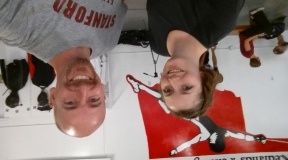We’re prévôts now! What’s a prévôt?
This weekend, we attended the annual meeting of the US Fencing Coaches Association. We spent three days learning and talking about many different aspects of coaching and fencing club management (I’ll talk more about what we learned in a future blog post). But the most important reason we went was to test for new certifications. Before the clinic I had a moniteur certification in foil and epee, and I have now upgraded my epee certification to prévôt. Dan was a prévôt in foil and saber, and has added the epee certification to be a prévôt d’armes (that is, of all three weapons). These crazy French terms, with their accents and multiple vowels, don’t immediately convey to outsiders what we are qualified to do and teach. Let’s talk about what they mean.
Imagine that you walk into a big club with a lot of coaches. The head coach, who may or may not have his name on the sign (Salle Liz has a nice ring to it, doesn’t it?) is giving a lesson to a top-level competitive fencer. Another coach is giving a lesson to another high-level fencer. A third coach is leading a group lesson, while a fourth helps the third coach by offering corrections or working one-on-one with a new student.
The guy with his name on the door is probably a maître (pronounced MAY-tra; French for master), which is the highest rank certified by the USFCA. In addition to giving lessons, the maître makes most of the decisions about the structure of the training program. He sets policies for the club, and is heavily involved in the training of most of the fencers, but especially the high-level competitive fencers. The maître has studied fencing for a long time, has a great understanding of tactics and techniques.
The other coach giving lessons is a prévôt (PREY-voh). Prévôt is French for provost, but that doesn’t really help much, since provost isn’t a word I use often. A prévôt is a high-level, knowledgeable coach, but not as well trained as a maître. They are still capable of giving fairly complicated lessons, in teaching group classes to fencers of all levels, and are well-versed in the art of training competitive fencers.
The third coach is a moniteur (mon-i-TOUR). They monitor (see what I did there) the fencers and assist the head coaches. In some clubs they might help the other coaches with group lessons, and in others they might conduct the group lessons themselves. A large part of the training and certification process for moniteurs focuses on conducting group lessons, while the higher certification lessons focus on individual lessons (more on that later).
The fourth coach is an assistant moniteur. I don’t know why, but we pronounce assistant in English and then moniteur all Frenchlike. Anyway the assistant moniteur is not really qualified to conduct an entire practice on their own, but they might teach some parts of it with another coach observing. The assistant moniteur helps by making corrections, working individually with folks who are struggling or new, and also generally contributes to the smooth running of practice. In my earliest days as a coach, I felt like one of my most valuable contributions to the club was pointing out available strips and finding fencers to fill those strips – basically, I made sure that the kids were fencing as much as possible. Many of those fencers were far more skilled than I, so I couldn’t really help them with tactics or techniques, but I made their practices more organized and efficient.
I’m planning to write about the certification process in a future blog post (read it: How to become a Prevot), but the short version is that at all levels there is a written component and a practical component. For assistant moniteurs the practical can be as simple as having a moniteur or higher observe them leading practices for 20 hours. The certification for a maître is obviously the most complicated, with well over an hour of the candidate doing a lesson with a student and demonstrating their ability to teach high-level concepts. The maître candidate must also write a thesis, just as you would if you were doing a master’s degree at a university. The USFCA wants to be sure that all levels of coaches are knowledgeable about fencing, but are also conscious of safety and keeping their athletes’ safety and well-being in mind. There’s more to running a club than attacks and parries, and the testing process reflects that.
The testing process allowed us to prove to high-ranking coaches that we’re solid, well-qualified coaches capable of running a great fencing program. But, as with any good test, we learned a lot too. We learned even more working with the presenters at the clinic – I did all three sessions with Andrey Geva of Alliance Fencing Academy right here in Houston, former US Women’s Epee coach, and Dan did his with Zoran Tulum of Zeta Fencing in Massachusetts, the US Men’s Sabre coach. Their presentations were amazing, and I plan to talk a LOT about what we learned and how we plan to implement it in a future blog post.
In the meantime, come to practice this week and let us show you the new stuff we’ve learned. I can’t wait to work on some of the techniques we saw for practicing hand touches, and to show you a new way of thinking about fleche attacks. Dan’s got some drills that you’ll all have a great time with. Get to practice and enjoy the benefits of all our hard work!





Leave a Reply
Want to join the discussion?Feel free to contribute!